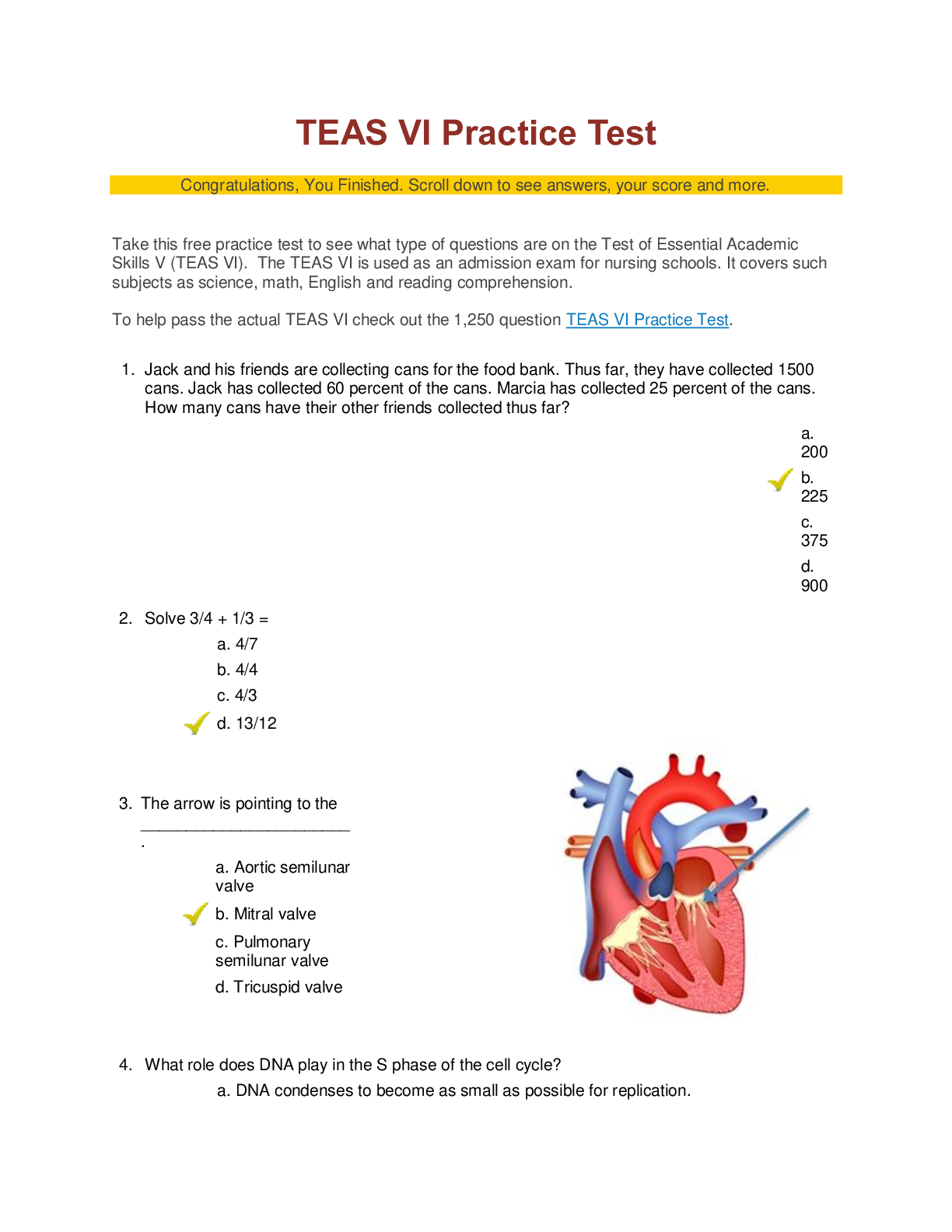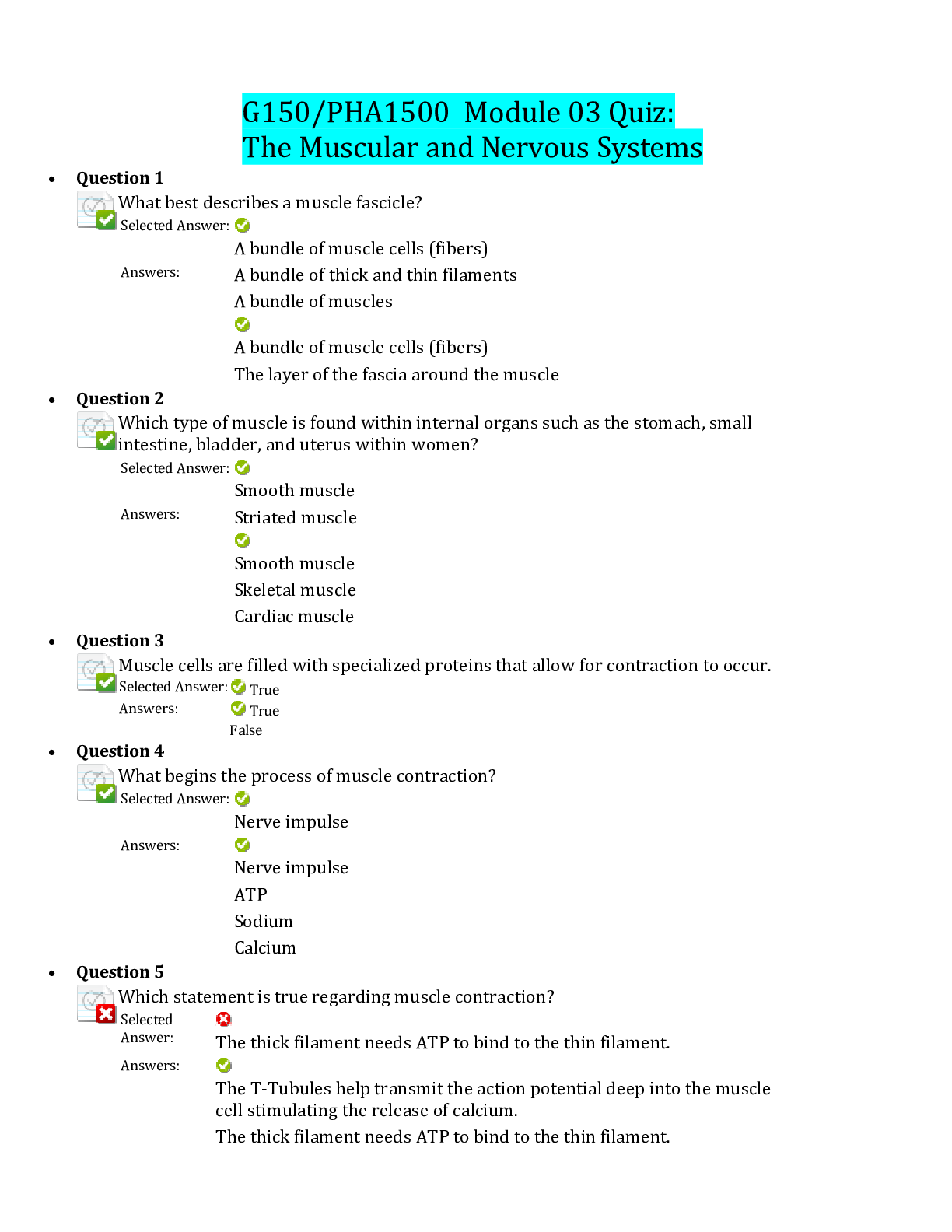NURSING. > EXAM > MPH 202 Epidemiology 1 Final Exam | Correctly Answered Latest Fall 2024/2025. (All)
MPH 202 Epidemiology 1 Final Exam | Correctly Answered Latest Fall 2024/2025.
Document Content and Description Below
MPH 202 Final Exam 4 points per question Section 1 (60 points) True/False (circle one answer) 1. In a cohort study, we start with exposure status and measure disease risk. T / F 2. A confou... nder must be an intermediary variable on the causal pathway between exposure and disease. T / F 3. Participants in a cohort study should be selected based on their disease status. T / F 4. We should not use a randomized trial to study a harmful exposure. T / F 5. Confounding is not the fault of the investigator. T / F 6. A randomized trial is the closest we can get to the ideal study design. T / F 7. In epidemiologic research, association equals causation. T / F 8. The results of standardization can depend on the standard population we choose. T / F 9. When calculating cumulative incidence, the numerator only includes new cases of disease. T / F 10. Restriction is one way to handle confounding in the design stage. T / F 11. A critical assumption of cumulative incidence is that everyone has been followed for different periods of time. T / F 12. A relative risk is a relative measure of comparison and an attributable risk is an absolute measure of comparison. T / F 13. If the relative risk (RR)=1.5, it that means that there is a 50% decreased risk in the exposed group compared to the unexposed group. T / F 14. The odds ratio can estimate the relative risk when the disease is rare. T / F 15. A major advantage of a randomized experimental study is that it rules out self-selection of subjects to the treatment and comparison groups. T / F Section 2. (60 points) Multiple choice; choose only 1 answer 16. A participant in a cohort study of risk factors for colon cancer does not contribute “time-at-risk” after he or she…. a. Was diagnosed as having colon cancer b. Died c. Was lost to follow up d. All of the above 17. Which of the following is not a strength of a case-control study a. Efficient b. Useful for a rare exposure c. Relatively inexpensive d. Examines multiple exposures 18. Which of the following may be directly computed from a case-control study? a. Odds ratio b. Relative risk c. Incidence rate d. All of the above 19. What is the aim of a cohort study? a. Study if exposure to a factor is associated with an outcome(s) b. Estimate risk of outcome in exposed and unexposed groups c. Compare the risk outcomes in two groups d. All of the above 20. All of the following are key characteristics of a confounding variable, except: a. Is not associated with the exposure b. It is associated with the disease c. Is not an intermediate step in the causal pathway d. Is an alternate explanation for an observed association between an exposure and disease 21. Which of the following is an advantage of a cohort study? a. The study population is the same with regard to the risk factors for disease b. The disease under study occurs rarely in the population c. The incidence of the disease is high in the non-exposed group d. The incidence of the disease is high in the exposed group 22. Analytic strategies to control for confounding include: a. Matching b. Multivariate analysis c. Stratification d. All of the above 23. One hundred newly diagnosed colon cancer patients are interviewed to determine their lifelong dietary history of fiber consumption. Healthy first-degree relatives who meet the “would if” criteria are selected as controls. We compare the proportion of cases reporting a history of high fiber consumption to controls. This is an example of a: a. Retrospective cohort study b. Case-control study c. Cross-sectional study d. None of the above 24. The distinguishing feature of a _____________ study is that at the time that the investigators begin enrolling subjects and collecting baseline exposure information, none of the subjects has developed any of the outcomes of interest. Fill in the blank with one answer below: a. Prospective cohort study b. Ecological study c. Case-control study d. Clinical trial Question 25 and 26 are related to the following scenario: A study is planned to investigate the relationship of factors associated with maternal hypertension and the risk of congenital birth defects in children born to these women. 25. Please choose the correct exposure and outcome below: a. The exposure is hypertension and the outcome is congenital birth defects b. The exposure is congenital birth defects and the outcome is hypertension c. The exposure is being female and the outcome is hypertension d. The exposure is congenital birth defects and the outcome is unknown 26. Which of the following would be a reason for using a cohort study design? a. The low rate of congenital birth defects (rare disease) b. It would be an efficient and cost-effective approach c. Testing hypotheses about several different risk factors for congenital birth defects such as maternal age, diabetes, and previous miscarriage history d. None of the above 27. How do you decide if a variable is a confounder in your data, or not? a. Compare crude and adjusted measures of association, if they differ by <10%, then the answer is “yes” b. If the crude odds ratio equals the adjusted measure of association, then the answer is “yes” c. Compare crude and adjusted measures of association, if they differ appreciably (>10%) then the answer is “yes” d. You can decide by just looking at the crude rate on its own 28. All are characteristics of a cause, except: a. It must precede the effect b. It can be either host or environmental c. It can either be positive (presence of a causative exposure) or negative (lack of a preventive exposure) d. All of the above 29. Which of the causal “Guidelines” suggested by Hill relates to the fact that if the association is observed repeatedly in different persons, places, times, and circumstances then it is likely to be causal. a. Strength of the association b. Specificity c. Analogy d. Consistency 30. Which of the following scenarios would you conclude that a variable is an effect modifier? a. The strata-specific odds ratios are equal b. The strata-specific odds ratios are appreciably different (>10%) c. The crude odds ratio and adjusted odds ratios are appreciably different (>10%) d. None of the above Section 3. (80 points) Computation and interpretation The following data come from a hypothetical case-control study of coronary heart disease (CHD) and diet: High Fat Low Fat CHD+ 50 50 100 CHD- 25 75 100 75 125 200 [Notice that outcome or not is the rows and exposure or not is the columns] 31. Calculate the proportion of the exposed who got the disease (this is the risk in the exposed). 32. Calculate the proportion of the unexposed who got the disease (this is the risk in the unexposed). 33. Calculate the relative risk. 34. Calculate the attributable proportion in the population. 35. 2.8 36. 2.0 37. 2.0 38a. Yes 38b. No 39. Compute the overall odds ratio and interpret it in words. 40. Interpretation: In this study subjects who had breast cancer were 2.26 times as likely as controls to consume a diet high in dietary fat. People who consume high amounts of dietary fat are often sedentary, so the data from the case-control study were stratified by sedentary behavior status: Dietary Non-sedentary Sedentary Fat Breast Ca Control Breast Ca Control Yes 8 16 63 36 No 22 44 7 4 41. Is there an association between sedentary and breast cancer? BC + MI - Total 63+7=70 36+4=40 110 8+22=30 16+44=60 90 100 100 200 42. Is there an association between sedentary behavior and dietary fat? 43-44. Compute the odds ratio for each stratum (each sedentary behavior group). 45. From the analysis so far, discuss whether you consider sedentary behavior a confounder, an effect modifier, or neither? What would be the appropriate effect measure to describe the association(s)? 46. In this case it would be appropriate to present a summary OR that will summarize what the relationship is taking into account the strata of the confounder. The commonly used summary is the Mantel-Haenszel. (This is more interesting in a case where the strata-specific ORs aren't = 1). 47. MH Calculation 48. Stratified analysis 49. Crude data 50. State your conclusions regarding the association between breast cancer and dietary fat in light of your findings of the role played by sedentary behavior in this study. [Show More]
Last updated: 4 months ago
Preview 1 out of 9 pages

Loading document previews ...
Buy this document to get the full access instantly
Instant Download Access after purchase
Buy NowInstant download
We Accept:

Reviews( 0 )
$9.00
Can't find what you want? Try our AI powered Search
Document information
Connected school, study & course
About the document
Uploaded On
Oct 14, 2019
Number of pages
9
Written in
Additional information
This document has been written for:
Uploaded
Oct 14, 2019
Downloads
0
Views
120




















